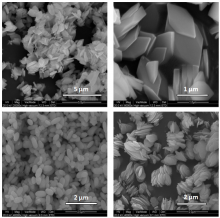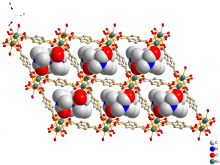Research
Our aim is to synthesize new lanthanide-based materials and study their luminescence. We are currently exploring four types of materials: lanthanide-doped nano particles, lanthanide metal-organic frameworks (MOFs), mononuclear lanthanide coordination compounds, and near- and mid-infrared emitting lanthanide-doped glasses.
Lanthanide-doped nano particles
Luminescent lanthanide-doped nano particles are investigated with several goals in mind: first of all, we try to learn more about the influence of different synthetic conditions on the morphology, growth, suspendibility and luminescence of these particles; second, by combining different lanthanides in one matrix, or by combining the appropriate lanthanide emission with the emission originating from the matrix itself, we set out to synthesize new luminescent materials, e.g. emitting white light; third, aiming towards biological (imaging) applications, we investigate the bio-compatibility of the best performing particles. We mainly use SEM and TEM to investigate the shape, size and morphology of the particels.
Lanthanide MOFs
Metal-organic frameworks belong to a relatively new familiy of materials, built up from metal ions that are connected by organic linkers (coordinating ligands with at least two coordinating moieties) to make a 3D structure. Many of these frameworks are porous and have very large surface areas. As such, they are being studied widely with different applications in mind, such as gas-storage, gas separation, catalysis, etc. A less frequently studied property of certain MOFs is luminescence. We investigate the influence of the linker type, substituents on the linker, presence of guest molecules, ... on the luminescence properties of lanthanide MOFs. The aim is the synthesis of new families of linker molecules, optimized for sensitizing lanthanide-centered luminescence. A crucial part of this research is the structural characterization of the newly synthesized MOFs. (Collaboration with prof. M. D’hooghe (BW11), prof. Vander Eycken (WE07), prof. Van Hecke (WE06), prof. Depla (WE04))
Mono- and oligonuclear lanthanide coordination compounds
Discrete mono- and oligonuclear lanthanide complexes are being investigated as luminescent materials. New ligand types are being designed and synthesized, to optimize the luminescence output of the corresponding lanthanide complex. Special attention goes to avoiding high-phonon molecular moieties (such as O-H, N-H and C-H) in the direct vicinity of the lanthanide ion.
Near- and mid-infrared emitting lanthanide-doped glasses
Materials that can emit in the near- and mid-infrared are being investigated for application in optical data transfer, laser development, chemical analysis, remote real-time spectroscopy, etc. We study the spectroscopic behaviour of glasses with transparency up into the mid infrared (beyond 2.5 μm), both from a theoretical point of view (Judd-Ofelt analysis, calculation of branching ratio’s, radiative lifetimes) and experimentally (absorption spectroscopy, steady-state luminescence spectroscopy in the range 250 – 5000 nm; time-resolved luminescence spectroscopy in the range 250 – 3100 nm). (Collaboration with prof. Jean-Luc Adam and prof. Xianghua Zhang, Equipe Verres et Céramiques, Université de Rennes, France)



